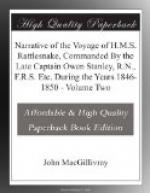(Footnote. In working to the eastward (in June) Bougainville for four days had “the wind constantly blowing very fresh, at East-South-East and South-East” (just as we found it) “with rain; a fog so thick that,” says he, “we were obliged to fire guns in order to keep company with the Etoile; and lastly, a very great sea, which hove us towards the shore. We could hardly keep our ground by plying, being obliged to wear, and to carry but little sail.” Bougainville’s Voyage round the World. Translation by Forster page 308.)
The island under which we thus anchored, is the westernmost and largest of a group of five, the next in size being about a mile in length, moderately high and wooded, and the remaining three mere rocks. The large Brumer Island is long and narrow, running East-North-East and West-South-West, two miles and two-thirds in greatest width; it is situated in latitude 10 degrees 45 minutes 30 seconds South and longitude 150 degrees 23 minutes East. The whole island presents a luxuriant appearance, being covered with cocoa-palms and other trees, and on the high ground several large fenced enclosures of cultivated ground—where among other plants we could distinguish the banana and sugar-cane—attested the fertility of the soil. The western, and at present the leeward side of the island, as viewed from our anchorage exhibits the appearance of a broken ridge on its southern half with several eminences topped by immense detached blocks of rock, partially concealed by the trees—to this, in the centre, succeeds a break occupied by a very low irregular cliff behind a bay with a sandy beach—afterwards the land rises suddenly to form a hill, 665 feet in height, with a steep face to the north-west, and a gradual slope backwards—and beyond this another hill, not so high (386 feet) but somewhat similar in form, shut out our further view in that direction. The mainland of New Guinea filled the background with a broken outline of ridges of wooded hills along the coast in front of a more distant and nearly continuous range of high mountains covered with trees up to their very summits.
NATIVES AND CATAMARANS.
Next morning we were visited by a party of natives from the neighbouring island, consisting of six men in a canoe, and one on a catamaran or raft. They were perfectly unarmed and came boldly alongside with a quantity of yams and coconuts for barter; when their stock was exhausted, they returned for more, and, accompanied by others, repeated the visit several times during the day. Although there was no obvious difference between these natives and those of the southern portion of the Louisiade, yet the catamaran was quite new to us, and the canoe differed considerably from any which we had seen before.
CATAMARANS AND CANOES.




